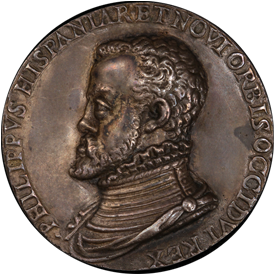In contemporary times, the existence of the American continent had little to no impact of the daily lives of Europeans, specifically in Spain, France, and England. We note the early Period of Discovery medals will feature rulers more often than founders, as the significance of the discovery of the New World did not yet bear any significance. Some may find it interesting that explorers such as Columbus, Cortez, and Pizarro are not commemorated on these medals, even though they were produced nearly a century after their conquests. Rather, names of insignificant individuals graced the fields of these medals. Although, that is not to say that characters such as Philip II were insignificant.
Included here is a footnote from the book American Colonial History Illustrated by Contemporary Medals (1894) by Charles Wyllys Betts and William Theophilus Rogers Marvin that offers some context to the dating of this series of medals: "The earliest numismatic reference to America is probably on the coins of Charles V, struck in Flanders in 1519, when he changed the motto NON PLUS ULTRA to PLUS ULTRA, and on his coins struck in 1555 with title REX INDIARVM. Charles abdicated October 25, 1555, retaining only the imperial titles used by the rulers of the "Holy Roman Empire." Philip then succeeded as King in the Netherlands, and in Spain, February 5, 1556, which approximately fixes the date of these pieces. Van Loon places them under 1555 — the year 1555 Old Style, ending in March 1556."
The Period of Discovery Betts Medals include Betts-1 to Betts-33.





























